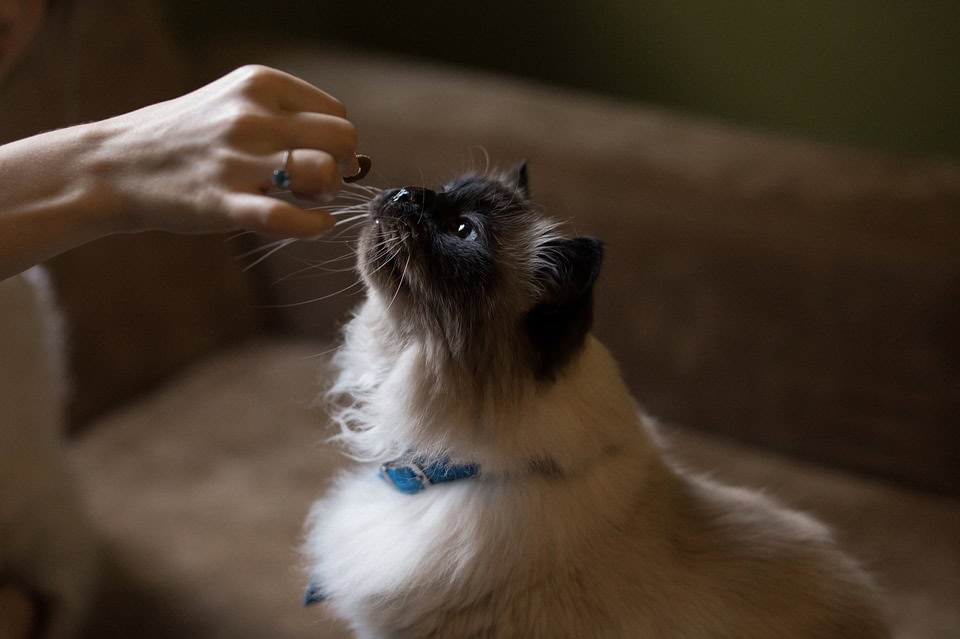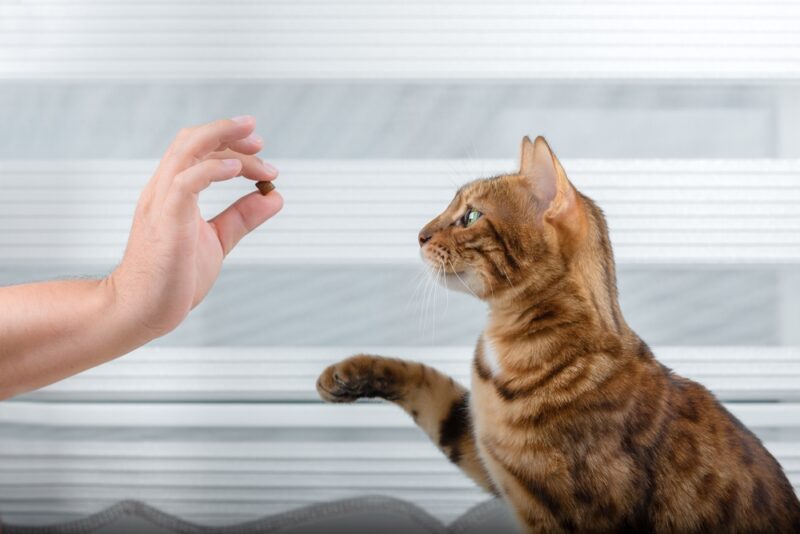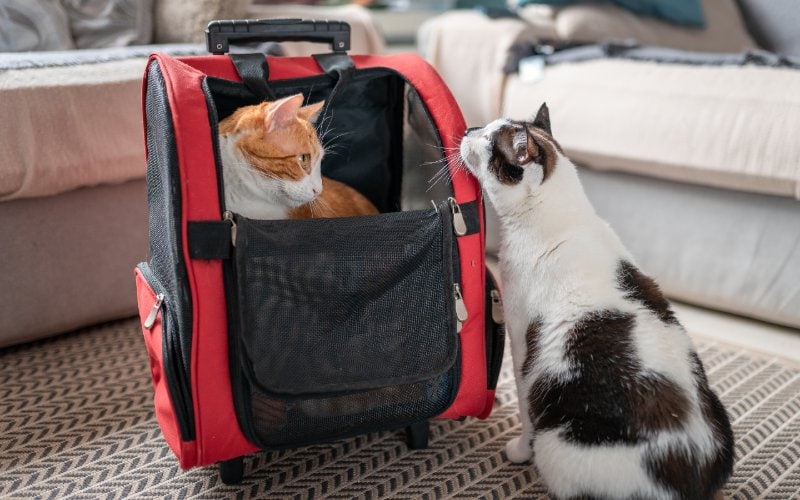VET APPROVED

The information is current and up-to-date in accordance with the latest veterinarian research.
Learn more »People often think that cats aren’t as trainable. While they may not catch on as quickly as dogs, cats can be trained to do things on command and even perform tricks. All you need is a bit of patience and a motivating reward!
One of the most straightforward first commands you can start with is teaching your cat to sit. This command can be helpful in various situations, such as when you’re preparing their dinner or when they need to be still for grooming. Keep reading to find tips for training your cat to sit on command.
Before You Start
- A quiet room free of distractions, far away from toys, other pets, and food bowls
- Training props (e.g., clicker, target stick, toys)
- Food reinforcers for treat-driven kitties (delicacies your kitty doesn’t get often work best like lickable treats or freeze-dried meat)
- Toy reinforcers for play-driven kitties (bring a minimum of two high-value toys to rotate throughout during training)
When Should We Train & How Long Should Sessions Last?
The best time to initiate a training session is before or between meals when your cat is more likely to be food-motivated. You’ll need to be cautious not to offer too many treats that will ruin your cat’s meal.
If you or your kitty aren’t feeling good or if neither of you is really in the mood to train, it’s best to wait until tomorrow for your next session. Training should be an enjoyable endeavor for both of you.
Cats have brief attention spans, so the most effective training sessions will be short and sweet. Your first few sessions should involve just a few treats and last only one or two minutes. Once your kitty understands that training sessions equal rewards, you can extend the sessions to two to five minutes.
 Top 4 Tips to Teach Your Cat to Sit
Top 4 Tips to Teach Your Cat to Sit
1. Try Clicker Training
A clicker is a great tool to use as you begin training your cat. The key to successful training is catching your kitty doing something you like (in this case, sitting on demand) and telling it that you like that behavior with a reinforcer. The clicker is one of the easiest ways to convey this message, as your kitty will soon recognize that the clicking sound identifies the positive behavior and results in a special treat.
The first goal with clicker training is getting your kitty to associate the clicking sound with a positive outcome. Bring a plate of treats and sit with your pet in a quiet room. Next, press the clicker and offer a treat to your cat. Continue clicking and offering treats to help start building a positive association or “charging” your clicker. Just don’t overdo it! It is not meant to be a sprint, but rather a daily practice. If your cat prefers toys over treats, press the clicker and offer the toy. After a few sessions, your cat will start looking at the treat or toy as soon as it hears the clicker.
Once your kitty knows that clicks mean rewards, you can try to “capture” the sitting behavior. Observe your cat during the day, and make sure you have the clicker and treats or toy handy, if your cat sits, press the clicker and offer a treat or toy. Your cat will not immediately recognize that their sitting caused the click and reinforcement. Continue observing, and when they sit again, click and reinforce. It won’t be long before your intelligent kitty realizes that sitting equals reward. Once it has made that connection, you can add the verbal cue “sit” before your cat starts to take a seat and then offer the reinforcement.

2. Use a Target Stick
Target sticks are another useful training tool you should have at your disposal. These long and lightweight sticks have a small ball at the end. They are often extendable, too. Target sticks provide a clear signal you can use to move your kitty from one point to another. They’re great for guiding your cat into carriers or backpacks and are useful in training tricks like going around objects. If you’re really feeling ambitious, why not teach them some agility training moves?
When you first introduce your target stick, your cat will likely lean in to sniff it. As soon as you see that nose-to-stick contact, use your clicker to click and then immediately offer a treat. Move the stick around your cat’s face, and as it follows the stick with its eyes and nose, its body may shift into the seated position. Click and offer a treat as soon as its bum hits the ground. Repeat this step several times until your kitty grasps the cue, at which point you can then replace your target stick with your finger.
Once your kitty knows that you expect it to sit when you raise your fingers above its head, add the verbal cue (“sit”) before they begin shifting into the seated position. Give them a treat, reset, and continue these same steps.
3. Choose High-Value Reinforcements as Rewards
Your cat will have more motivation for training if it receives a high-value reinforcement for its good behavior. If you’re offering something your cat gets every day as a reward, it won’t be as motivating for your cat to participate. Try a few different treats if your kitty is food-driven or new toys if it is play-driven to see what floats your cat’s boat. Once you know what treat or toy excites your pet, reserve that reinforcement for training sessions only.
If you’re opting for a food reinforcer, try strong-smelling treats. Cats will respond first to scents, so if the treat you’re offering doesn’t smell good, your kitty might just turn its nose up at it. Fishy treats may make you gag, but your cat could go ga-ga for them. Some people find their cats enjoy a small sardine as a reward. Determine your kitty’s favorite treat through trial and error. Remember, only give them small amounts of said treat so you won’t upset their tummies or ruin their next meal. Breaking the treats into the smallest manageable but still significant pieces can help you have more training and reinforcing opportunities, while giving your cat “more wins.”
If your cat is toy driven, test out a few different types of toys to determine its favorite. A feather wand, catnip toys, fetch ball, or toy mouse are great toys to start out with. Once you know what kind of toy your kitty likes, use it as an incentive to get your pet motivated to perform well during training. Put it away and don’t let your kitty play with it in between training sessions. Also, don’t be afraid to introduce some variability in your reinforcements by mixing outcomes of toys and treats. This will help to keep your kitty motivated.

4. Practice & Patience
The two P’s will get you and your kitty through each training session. Remember that every cat is unique; some may learn faster than others. You and your cat may become frustrated during your training sessions, and if this happens, it’s best to stop for the day and try again tomorrow.
Never try to force your cat to sit, and never punish your pet for not catching on as quickly as you’d like. Your cat will start associating you with negative feelings if you start punishing it. Cats respond well to positive reinforcement and find dominance or punishment stressful. Stressed-out cats are more likely to present problematic behaviors like eliminating outside their litter boxes and excessive grooming. Don’t hesitate to contact your veterinarian and ask for help if you would ever encounter behavioral issues with your cat.

Final Thoughts
Training your cat to sit is the first of many commands you can teach your pet. Once they realize that performing certain behaviors gets them a tasty treat or a fun play session with their favorite human, you will be amazed at what other things your cat will be eager to learn. Remember to be patient, and keep it interesting, variable, and fun to ensure the best results.
Featured Image Credit: Svetlana Rey, Shutterstock

 Top 4 Tips to Teach Your Cat to Sit
Top 4 Tips to Teach Your Cat to Sit









